Salut Salut!
Sunday, 19 July 2015
How To Cook With Wine?
Cooking With Wine - How To Cook With Wine
How To Cook With Wine:
Wine has three main uses in the kitchen - as a marinade ingredient, as a cooking liquid, and as a flavoring in a finished dish.
The function of wine in cooking is to intensify, enhance, and accent the flavor and aroma of food - not to mask the flavor of what you are cooking but rather to fortify it.
As with any seasoning used in cooking, care should be taken in the amount of wine used - too little is inconsequential and too much will be overpowering. Neither extreme is desirable. A small quantity of wine will enhance the flavor of the dish.
The alcohol in the wine evaporates while the food is cooking, and only the flavor remains. Boiling down wine concentrates the flavor, including acidity and sweetness. Be careful not to use too much wine as the flavor could overpower your dish.
For best results, wine should not be added to a dish just before serving. The wine should simmer with the food, or sauce, to enhance the flavor of the dish. If added late in the preparation, it could impart a harsh quality. It should simmer with the food or in the sauce while it is being cooked; as the wine cooks, it reduces and becomes an extract which flavors. Wine added too late in the preparation will give a harsh quality to the dish. A wine needs time to impart its flavor in your dish. Wait 10 minutes or more to taste before adding more wine.
Remember that wine does not belong in every dish. More than one wine-based sauce in a single meal can be monotonous. Use wine is cooking only when it has something to contribute to the finished dish.
Salut Salut!
Does white wine really send women crazy? From tears to tantrums, MailOnline investigates why this particular drink causes such carnage
Does white wine really send women crazy? From tears to tantrums, MailOnline investigates why this particular drink causes such carnage.
There was a time when an evening with friends was synonymous with a nice, chilled bottle of Sauvignon Blanc (or four).
But as the years have rolled by, that crisp, glass of gooseberry-flavoured nectar has fallen out of favour.
'No white wine for me - it sends me mental,' is how it started. 'Nor me,' said another friend, and on it went.
In fact, over the last few years, nearly a dozen of my female friends have declared they can no longer drink what used to be our favourite tipple.
One was almost arrested, another broke her wrist and another very nearly got run over.
There are countless other tales of tears, tantrums and Tube journeys going disastrously wrong.
But what is it about the drink of choice for so many women that sends them doolally - or 'psychotic', as one friend confessed?
Is there something in the wine itself or is it the way we consume it that wreaks such havoc?
Firstly, different people react to alcohol in very different ways, Dr Sarah Jarvis, medical adviser to the charity Drinkaware.
'Women react more quickly to alcohol,' she explained. 'If you’re a sturdy woman, you might think you can drink any scrawny man under the table - but don’t be fooled.
'Even if a woman is the same size as a man, she will have more body fat and less body water.
'Since alcohol is only distributed in body water, you’ll have a higher proportion of it in your bloodstream.’
This, she says, may be why women tend to suffer from worse hangovers.
Indeed, researchers at the University of Missouri-Columbi found that not only do women get drunk faster, but their hangover symptoms were more severe - even though they drank the same amount as the men.
Then there's eating on on an empty (or at least emptier than many a man's) stomach, which one study likened to taking alcohol intravenously.
Salut Salut!
6 Reasons Why a Little Glass of Wine Each Day May Do You Good
6 Reasons Why a Little Glass of Wine Each Day May Do You Good
2. Keep the scale in your cornerStudies find that people who drink wine daily have lower body mass than those who indulge occasionally; moderate wine drinkers have narrower waists and less abdominal fat than people who drink liquor. Alcohol may encourage your body to burn extra calories for as long as 90 minutes after you down a glass. Beer seems to have a similar effect.
3. Boost your bodys defensesIn one British study, those who drank roughly a glass of wine a day reduced by 11% their risk of infection by Helicobacter pylori bacteria, a major cause of gastritis, ulcers, and stomach cancers. As little as half a glass may also guard against food poisoning caused by germs like salmonella when people are exposed to contaminated food, according to a Spanish study.
4. Guard against ovarian woesWhen Australian researchers recently compared women with ovarian cancer to cancer-free women, they found that roughly one glass of wine a day seemed to reduce the risk of the disease by as much as 50 percent. Earlier research at the University of Hawaii produced similar findings. Experts suspect this may be due to antioxidants or phytoestrogens, which have high anticancer properties and are prevalent in wine. And in a recent University of Michigan study, a red wine compound helped kill ovarian cancer cells in a test tube.
5. Build better bonesOn average, women who drink moderately seem to have higher bone mass than abstainers. Alcohol appears to boost estrogen levels; the hormone seems to slow the bodys destruction of old bone more than it slows the production of new bone.
6. Prevent blood-sugar troublePremenopausal women who drink one or two glasses of wine a day are 40 percent less likely than women who dont drink to develop type 2 diabetes, according to a 10-year study by Harvard Medical School. While the reasons arent clear, wine seems to reduce insulin resistance in diabetic patients.
Salut Salut!
This $18,000 Bottle of Wine May Be Undrinkable
A bottle of one of the world's rarest wines sold for $18,000 at a London auction Thursday. There's just one problem - it may be undrinkable.
The Chateau Mouton Rothschild 1945 went to a private collector in Europe, auction house Bonhams said. The selling price - which equals about $1,500 a glass and could cover a Learjet charter from London to Saint-Tropez - was at the low end of expectations because the bottle may have suffered from too much oxidation.
The ullage, an industry term which refers to the space between the wine and the bottom of the cork, was below the neck of the bottle, '' which points to an increased chance of the wine being oxidized and undrinkable,'' said Richard Harvey, Bonhams' global head of wine, in an interview before the sale. Had it been in better condition, the 70-year-old bottle, part of a vintage described by critic Michael Broadbent as the "Churchill of wine," could have fetched twice the 10,000-pound ($15,000) to 15,000-pound range Bonhams had estimated in its sale catalog.
At 11,750 pounds, which includes a fee of 1,750 pounds to cover administrative costs, the bottle's price would cover the full tuition for a year at the London School of Economics. In its catalog, Bonhams says ullage levels increase with age but the house only auctions wines it considers to be in sound condition.Even spoiled, the claret is sought after for its historical value. The V on its label, designed by the French illustrator Philippe Jullian to celebrate the Allies' victory over Nazi Germany in the Second World War, also represents triumph over difficult weather conditions for Bordeauxvineyards at the time, including heavy frost and a heatwave that led to a drought.
Totally cool right!
Salut Salut!
Best Non Alcoholic Wine: Is There Such a Thing?
Best Non Alcoholic Wine: Is There Such a Thing?
So What Is the Best Non Alcoholic Wine?
Please see my picks below.
| Picture | Name | Process | Verdict | Price | Rating |
|---|---|---|---|---|---|
| Picture | Name | Process | Verdict | Price | Rating |
 | Ariel Cabernet Sauvignon Non Alcoholic Red Wine | Reverse Osmosis / Cold Filtration | Probably best non-alcoholic red wine out there. Doesn't taste exactly like red wine, but comes as close as you're gonna get with non-alcoholic wine. | $$$$ | 3.5 |
 | Ariel Chardonnay Non Alcoholic White Wine | Reverse Osmosis / Cold Filtration | One of the best non-alcoholic white wines out there. Less sweet compared to some of the others and worth a try. | $$$$ | 4.0 |
 | Sutter Home Fre White Zinfandel Non Alcoholic Wine | Distillation | A little tart, and less sweet than other non alcoholic wines. Paired with a light meal like chicken or pasta with white sauce is best. | $$$$ | 4.2 |
 | Sutter Home Fre Brut Non Alcoholic Wine | Distillation | Good alternative for alcoholic sparkling white wines that is reasonably priced as well. | $$$ | 4.0 |
 | Pure Vitis-Merlot Organic Grape Juice | Juice | Although not technically wine, this one is worth a try. A little too sweet for my taste, it may suit some. | $$$ | 3.0 |
Salut Salut!
Two Local wines you never knew about!
Two Local wines you never knew about!
It was very hard to track down a perfect explanation of these two wines but I believe Felix did it justice.
Cerise Wine
As a boy growing up in the 80’s, the Cerise fruit ( Flacourtia indica ) was not much of a favourite of mine. First of all, the tree had a lot of picka (thorns) and that was a turn off, because you couldn’t climb the tree readily. Then you had to deal with the fruit itself. There were a lot of seeds to contend with and after wrestling with the seeds in your mouth for a while there wasn’t much “flesh” to eat. Jeezan ages!
But, it was all good and helped us pass time. Purpled tongues and maybe a bit of “rack” or “tie tongue” sensation in our mouths was commonplace between my friends and I as we raided a Cerise tree or two. And, it would have been short lived anyway because by then Pommerac would have been in season and the Pommerac tree would have been laden with fruit, boughs almost to touch the ground, straining under the weight, begging us to ease its burden lol!……
Those were the days. The seedy Cerise fruit left an indelible taste memory in my mind and I cannot get it out of my head. That’s where the idea for the wine came or rather popped into my mind one day. So, while up in the countryside mom got my nephew to pick some of the fruit to make some Cerise wine since it was not commonly done at home. We were accustomed to more passion fruit, rice, cashew, guava, pommerac and five finger wine, made just in time for the Christmas season. So off to another wine making adventure we went……
…….As I held the bottle of red tinged Cerise wine up against the light to admire the colour, I sighed. It was worth it, one sip and the fruitiness was there like I remembered when I was young; pastelle shades of flavour tingled my taste buds and evoked all those taste memories that were locked away; waiting for the right time; the right stimulus; to be alive again if but for a moment taking you down memory lane.
Five Finger Wine
Wine from plants, barks and flowers??? Yep, that’s right. We have taken plants like the famous Chadon Beni (Eryngium Foetidum), Aloes ( Aloe vera), Timarie ( Neptunia Aquatica ), the aphrodisiac bark Bois Bande ( Roupala Montana ) and even Hibiscus flowers to make wine. Personally, I haven’t tasted the chadon beni and timarie but common ones like guava, passion fruit, cashew, cane, rice etc I have had at one time or another while house paranging, at a lime or from friends…. I even heard of some people using dasheen to make wine….in fact I think we Trinis could take almost anything to make wine LOL!!
Anyhow, today I’m going to show you how to make five finger wine. From the looks of it though, you could substitute the five finger with any other fruit and make any other type of wine as well. The steps are simple to follow; just make sure everything is sterilized with hot water. Here’s five finger ( carambola, star fruit) wine. Enjoy the fruitiness!
Salut Salut!
How to pair Wine and Food?
How to pair Wine and Food?
We have all been here, either when preparing for a hot date or trying to impress an in-law. Here is a way to be the expert of the occasion.
Salut Salut!
5 Ways To Open A Wine Bottle Without A Corkscrew
5 Ways To Open A Wine Bottle Without A Corkscrew.
Corkscrews have a nasty habit of playing hide and seek on the days you need a glass of wine the most. The stress of every minute that passes as you and your wine bottle wonder what to do next just multiplies the number of glasses you’ll need to wind down. We’ve all been there. But there’s hope. Here are 5 ways to open a wine bottle without a corkscrew.
1. Open it with your shoe
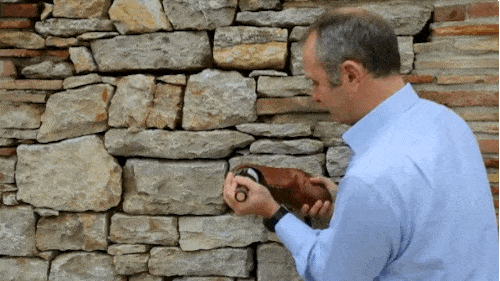 (Source: Mirror / Mirabeau Wine)
(Source: Mirror / Mirabeau Wine)
Yes, this is a real way to open a wine bottle. Remove the wrapping around the cork first, then place your bottle in the shoe. Give it a few good whacks against a (solid) wall, and watch the cork inch its way out. Voila! You may now proceed with chugging your wine in celebration.
2. Take a hammer to it
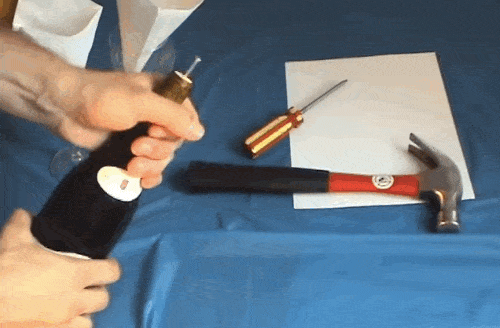
Not in the way you’re thinking, although that would be one satisfying way to do it. But to avoid shattering the glass, you’ll also need a screw, which you’ll twist down into the cork. Then use the back of the hammer to yank out the screw and cork together. At this point it will be acceptable to insist all your friends refer to you as Bacchus.
3. Knife it
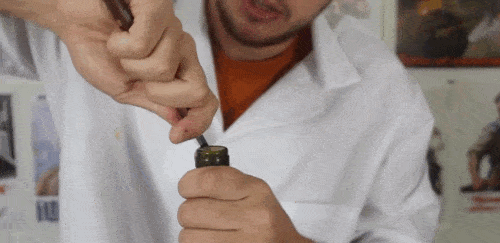
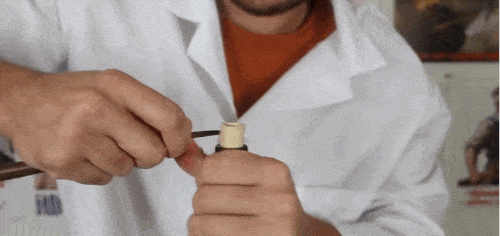
Grab a serrated knife and remove any foil covering. Stick the knife in near the edge of the cork and VERY carefully, start twisting. By pulling up and turning with the knife, the cork will begin to work its way out. When it’s a good bit out of the bottle, but not quite far enough to be pulled the rest of the way by hand, take the knife out and stick it in the side of the cork. Turn and twist until that sweet, velvety goodness flows free.
4. Pump it

(Source: YouTube / Kristy Kreme’s channel)
Should you find yourself stuck in a bike shop or your garage with a bottle of wine, as one often is, grab the nearest bicycle pump. Wedge the pump into the cork and use some good old fashioned physical and peer pressure to pop it right out of the bottle. This also just looks like a lot of fun.
5. String it

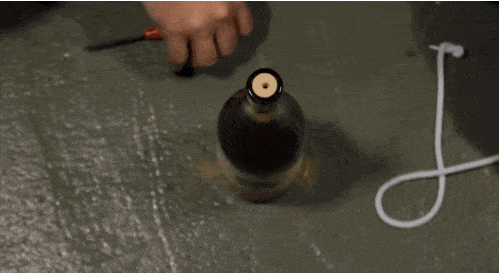

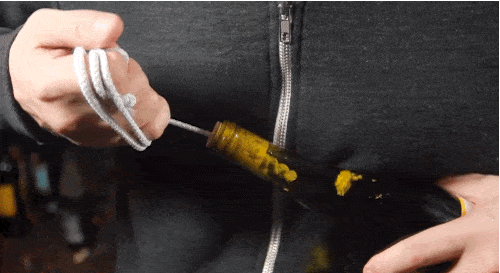
Using a screw driver, or any long, skinny, metal device, make a hole all the way through the cork. Then take a good sized piece of string or rope and tie a knot at the end. Shove that thing down through the hole in the cork, then yank it back out. This will force the cork out, if you’re strong enough. I can’t think of any better reason to start working out than to be able to open your wine bottle, especially in front of judgmental house guests.
Salut Salut!
Wine and its Origins - The Archaeology and History of Wine Making
Wine and its Origins - The Archaeology and History of Wine Making
Wine is an alcoholic beverage made from grapes; and depending on your definition of "made from grapes" there are at least two independent inventions of the lovely stuff. The oldest known possible evidence for the use of grapes as part of a wine recipe with fermented rice and honey was in China, about 9,000 years ago. Two thousand years later, the seeds (or I suppose pips) of what became the European wine-making tradition began in western Asia.
Archaeological Evidence
Archaeological evidence of wine-making is a little difficult to come by, of course; the presence of grape seeds, fruit skins, stems and/or stalks in an archaeological site does not necessarily imply the production of wine. Two main methods of identifying wine making that are accepted by scholars are identifying domesticated stocks, and discovering grape processing evidence.
The main change incurred during the domestication process of grapes is that the domesticated forms have hermaphrodite flowers. What that means is that the domesticate forms of the grape are able to self-pollinate. Thus, the vintner can pick traits she likes and, as long as she keeps them all on the same hillside, she need not worry about cross-pollination gumming up the works.
The discovery of parts of the plant outside its native territory is also accepted evidence of domestication. The wild ancestor of the European wild grape (Vitis vinifera va. sylvestris) is native to western Eurasia between the Mediterranean and Caspian seas; thus, the presence of V. vinifera outside of its normal range is also considered evidence of domestication.
Chinese Wines
But the story really must start in China. Residues on pottery sherds from the Chinese early Neolithic site of Jiahu have been recognized as coming from a fermented beverage made of a mixture of rice, honey and fruit, radiocarbon dated to ~7000-6600 BC. The presence of fruit was identified by the tartaric acid/tartrate remnants in the bottom of a jar, familiar to anyone who drinks wine from corked bottles today. Researchers could not narrow the species of the tartrate down between grape, hawthorn, or longyan or cornelian cherry, or a combination of two or more of those. Grape seeds and hawthorn seeds have both been found at Jiahu. Textual evidence for the use of grapes (but not grape wine) date to the Zhou Dynasty (ca 1046-221 BC).
If grapes were used in wine recipes, they were from a wild grape species native to China-there are between 40 and 50 different wild grape species in China-not imported from western Asia. The European grape was introduced into China in the second century BC, with other imports resulting from the Silk Road.
Western Asia Wines
The earliest firm evidence for wine-making to date in western Asia is from the Neolithic period site called Hajji Firuz, Iran, where a deposit of sediment preserved in the bottom of an amphora proved to be a mix of tannin and tartrate crystals. The site deposits included five more jars like the one with the tannin/tartrate sediment, each with a capacity of about 9 liters of liquid. Hajji Firuz has been dated to 5400-5000 BC.
Sites outside of the normal range for grapes with early evidence for grapes and grape processing in western Asia include Lake Zeriber, Iran, where grape pollen was found in a soil core just before ~4300 cal BC. Charred fruit skin fragments were found at Kurban Höyük in southeastern Turkey by the late 6th-early 5th millennia BC.
Wine importation from western Asia has been identified in the earliest days of dynastic Egypt. A tomb belonging to the Scorpion King (dated about 3150 BC) contained 700 jars believed to have been made and filled with wine in the Levant and shipped to Egypt.
European Wine Making
In Europe, wild grape (Vitis vinifera) pips have been found in fairly ancient contexts, such as Franchthi Cave, Greece (12,000 years ago), and Balma de l'Abeurador, France (about 10,000 years ago).
Excavations at a site in Greece called Dikili Tash have revealed grape pips and empty skins, direct-dated to between 4400-4000 BC, the earliest example to date in the Aegean.
A wine production installation dated to ca. 4000 cal BC has been identified at the site ofAreni 1 in Armenia, consisting of a platform for crushing grapes, a method of moving the crushed liquid into storage jars and (potentially) evidence for the fermentation of red wine.
- Anddd There you have it
- Salut Salut
How to Pour Wine Without Dripping
Learn how to pour wine with a few wine serving tips that will give you confidence. Who knows, maybe next you’ll be pouring wine perfectly out of a jeroboam sized bottle.
Salut Salut!
Does the Color of Wine matter?
Does the Color of Wine matter?
Lets venture into the different colors of wine and what they mean.
Top 10 wine brands 2015
Top 10 wine brands 2015
Wine is timeless but some wines stand out. Here are my top picks for best wines of 2015
10. Jacob’s Creek
Owner: Pernod-Ricard
Volume 2013: 6.6m 9l cases
Volume 2014: 6m 9l cases
Change: -9%
Owner: Pernod-Ricard
Volume 2013: 6.6m 9l cases
Volume 2014: 6m 9l cases
Change: -9%
9. Beringer
Owner: Treasury Estates
Volume 2013: 7.2m 9l cases
Volume 2014: 7.15m 9l cases
Change: -0.7%
Owner: Treasury Estates
Volume 2013: 7.2m 9l cases
Volume 2014: 7.15m 9l cases
Change: -0.7%
8. Lindemans
Owner: Treasury Estates
Volume 2013: 7.2m 9l cases
Volume 2014: 8.1m 9l cases
Change: +12.5%
Owner: Treasury Estates
Volume 2013: 7.2m 9l cases
Volume 2014: 8.1m 9l cases
Change: +12.5%
7. Hardy’s
Owner: Accolade Wines
Volume 2013: 13.2m 9l cases
Volume 2014: 9.4m 9l cases
Change: -28.8%
Owner: Accolade Wines
Volume 2013: 13.2m 9l cases
Volume 2014: 9.4m 9l cases
Change: -28.8%
6. Yellow Tail
Owner: Casella Wines
Volume 2013: 12.5m 9l cases
Volume 2014: 10.5m 9l cases
Change: -16%
Owner: Casella Wines
Volume 2013: 12.5m 9l cases
Volume 2014: 10.5m 9l cases
Change: -16%
5. Sutter Home
Owner: Trinchero Family
Volume 2013: 11.2m 9l cases
Volume 2014: 10.85m 9l cases
Change: -3.1%
Owner: Trinchero Family
Volume 2013: 11.2m 9l cases
Volume 2014: 10.85m 9l cases
Change: -3.1%
4. Robert Mondavi
Owner: Constellation
Volume 2013: 11.9m 9l cases
Volume 2014: 12.1m 9l cases
Change: +1.3%
Owner: Constellation
Volume 2013: 11.9m 9l cases
Volume 2014: 12.1m 9l cases
Change: +1.3%
3. Concha y Toro
Owner: Concha y Toro
Volume 2013: 13.2m 9l cases
Volume 2014: 14.2m 9l cases
Change: +7.6%
Owner: Concha y Toro
Volume 2013: 13.2m 9l cases
Volume 2014: 14.2m 9l cases
Change: +7.6%
2. Gallo
Owner: E&J Gallo Winery
Volume 2013: 15m 9l cases
Volume 2014: 14.5m 9l cases
Change: -3.3%
NOTE: Product range: Gallo Family Vineyards, Summer/Autumn range, Spritz, Turning Leaf, Coastal Vineyards, Signature Series. Other group brands NOT included in this ranking: Barefoot, Redwood Creek, Barefoot, Apothic, Frei Brothers Reserve, Mirassou, Louis M. Martini, Dancing Bull, Starborough, and fortified wine brands.
Owner: E&J Gallo Winery
Volume 2013: 15m 9l cases
Volume 2014: 14.5m 9l cases
Change: -3.3%
NOTE: Product range: Gallo Family Vineyards, Summer/Autumn range, Spritz, Turning Leaf, Coastal Vineyards, Signature Series. Other group brands NOT included in this ranking: Barefoot, Redwood Creek, Barefoot, Apothic, Frei Brothers Reserve, Mirassou, Louis M. Martini, Dancing Bull, Starborough, and fortified wine brands.
The top of the list! One of my favs
1. Barefoot
Owner: E&J Gallo Winery
Volume 2013:18.1m 9l cases
Volume 2014: 18m 9l cases
Change: -0.6%
Owner: E&J Gallo Winery
Volume 2013:18.1m 9l cases
Volume 2014: 18m 9l cases
Change: -0.6%
Salut Salut!
Subscribe to:
Comments (Atom)














